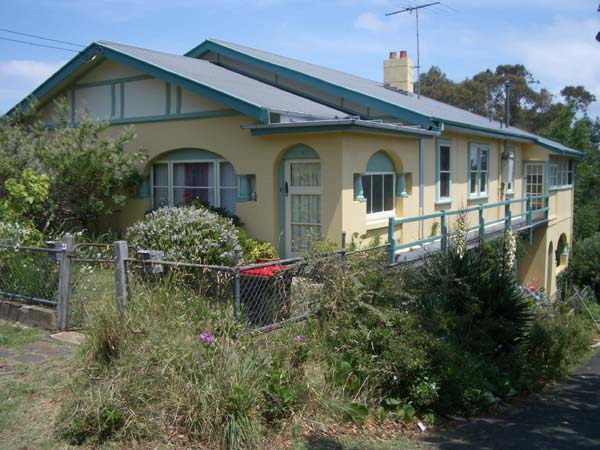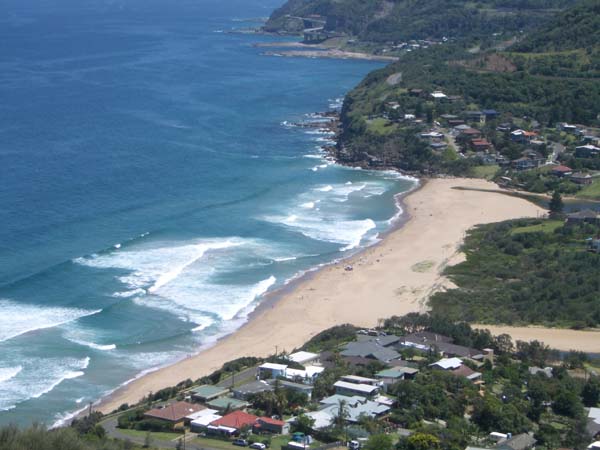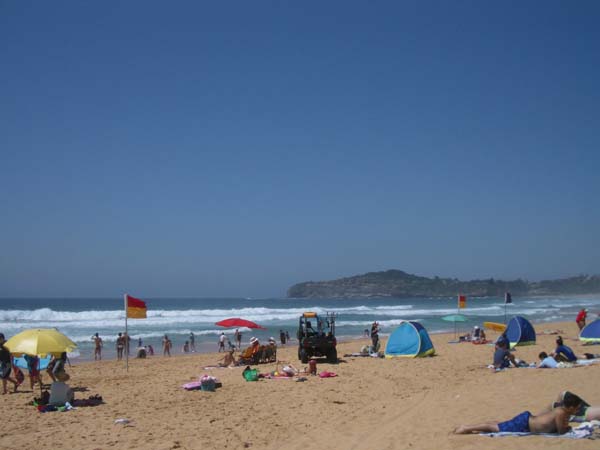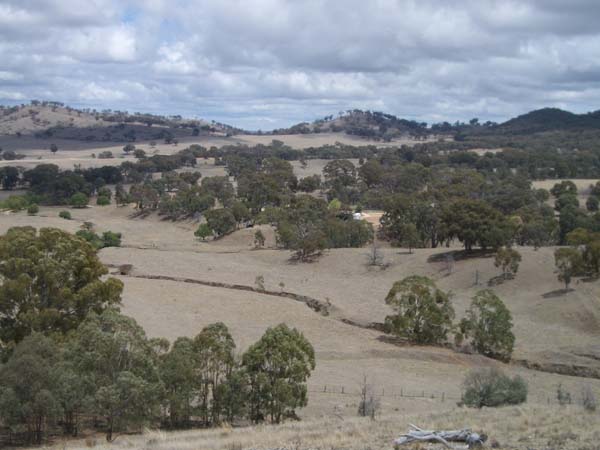
Return to home page Read December 2006 blog
Go to my 2001-2 Australia travel book
Send a comment
Other blogs I'm reading: Christine Allen's // Gordon Price's
January 22, 2007: 8
weeks to the day from our leaving Vancouver, we've moved to Warialda
Street in Katoomba.  Our new home is a purpose-built triplex from the 1920s, with two mirror image flats on the main floor and a third one (whose entrance is visible on the extreme right) on the floor below above the back garden. We're going into the back one initially. I will be posting much more info and photos once we're established and have sorted out internet, etc., which may take a while. |
| January 21, 2007: The
hot, dry, windy weather that has been plaguing Melbourne for the past
several days has arrived in otherwise humid Sydney. Temperature in the
mid-30s and, for me, a strange sense of déja vu. Why does it
seem so familiar? I was asking myself, very different from the humid
heat of a week ago that only reminded me of my few summertimes in
Ontario or Quebec. Because it's the summertime weather of the Fraser
Canyon, or Spences Bridge or Walhachin -- all the dry places in the BC
interior where a hot wind blows in July and August and the reflected
heat is like a convection oven, where I spent so much time painting for
Vanishing BC
a few years
ago. Up to about 34 today here, with a "southerly change" predicted
this evening -- the classic Sydney respite from hot weather -- and rain
coming for a few days of next week. In the sky to the northeast, a pall
of blue-brown smoke from a small bushfire in the park that
provides a border to Sydney's northward march -- that explains the
distant sirens. The "firies" are on the way. [I wrote the above paragraph mid-afternoon. The temperature actually topped out at between 39 and 42 in the northern Sydney suburbs. We stayed inside in the evening, ate Indian takeaway and watched the cricket on TV. The wind dropped away and it seemed to become hotter, the air still and the house stuffy. But the following morning, I could tell that the southerly had arrived without even lifting my head from the pillow, as the jets were coming overhead on their approach to Sydney airport. The temperature had dropped several degrees. I realize how well I have come to know this city when I can tell the weather forecast from airplane noise.] Mentioning petrol prices again, as I did on January 17, suddenly they all dropped 7 cents a litre! This because, according to the paper, the Australian Competition and Consumer Commission chairman had just "shamed" the petrol companies into reducing their profit margins. |
| January
19, 2007: Globalisation,
etc. etc. (note the non-"z" spelling, an example of non-globalization).
Blundstone, the 130-year-old Tasmanian boot manufacturer, announced the
other day that it was moving its production facilities offshore,
removing 300 or so jobs from Tassie's rather depressed economy.
Blundstones are as essentially Aussie as Akubra hats or Drizabone coats
or schooners of beer or Vegemite jaffels, an essential part of the
outback image (a feature of "Mr. Outback" competitions was the standing
broadjump in elastic-sided boots, of which Blundstones is the most
famous brand). I recall a Blundstone shop on 4th in Kitsilano. The CEO
said its labour costs offshore would be about 10% of its current ones,
so let's guess how much the cost of a pair of Blundstones will decline
once the shift is made: do I hear 1%? ... 0%? So, looking at setting up efficiently and cheaply in our soon-to-be home, we chugged off to Ikea at Homebush, very near the Olympic Stadium. It is part of a huge shopping centre, a really enormous one, the kind that are gradually moving retailing to the North American model and leaving the old "shopping village" streets next to the railway stations in a marginal role. Being in Ikea was a truly weird experience as I kept flashing onto the idea that I was in the one in Richmond, BC. It was i-d-e-n-t-i-c-a-l, except for the chilly air-conditioning. As an amusement, I checked the source of all the kitchen and bedroom bits we came across: the score was 95% China, 2% Turkey, with the balance divided between Poland, India and Thailand. The march of art: according to the Sydney Morning Herald, "Gosford City Council will close a controversial art exhibition a week early after police called photographs of a naked 7-year-old girl disturbing and complainants said the images were 'child abuse and not art.'" Artist Polixeni Papatretrou posed her daughter suggestively, wearing only her grandmother's jewellery; according to the artist's statement, the poses were "orchestrated by the child herself" and showed "resonant feminity, flirtation and self-awareness." This the week after the debut of a musical based on the Australian children's classic "Snugglepot and Cuddlepie," which was good, said the reviewer, but lacked enough hummable tunes. In Melbourne, Aussies of Serbian and Croatian ancestry had a huge punchup at the Australian Open tennis competition. Serbian and Croatian tennis stars were competing, and the barracking [cheering of the supporters] got out of hand. And, anyone who's been to Sydney would think, "perfect climate for cycling" while coming to the conclusion that only a fool would risk the horrible traffic and bumpy roads. The latest blow to sustainability came yesterday when the private owner of the M2 motorway in western Sydney closed down a 5-km stretch of cycleway to create an extra westbound traffic lane. This will force cyclists onto hilly side roads before they can rejoin the motorway. Motor traffic had risen steadily, in spite of a toll increase from $3.80 to $4.40. And that's all the latest news from Aus -trial -ee-ya .... |
| January
17, 2007: It
being Wednesday morning, everyone in Sydney tries to find an
opportunity to fill up with petrol. In this advanced free-enterprise
state, the petrol stations have their lowest prices on Tuesday and
Wednesday morning, and then as sure as you pronounce avocado
aw-voh-caw-do, the price jumps by at least 10 cents a litre on
Wednesday afternoon. So, from about $1.10 to $1.20. Everywhere. Every
station. Every brand. A further reflection after being here nearly 7 weeks: you very rarely see police, and rarely hear sirens. That was as true in inner-city Surry Hills as it is here in leafy Turramurra. There are very very few homeless people, and almost none of the obviously mentally ill people who were so much a feature of life in South Granville/West End Vancouver for the summer-fall of '06 before we came here. No binners. No one with shopping carts containing all their possessions. So the safety net here appears to have smaller holes in it .... However, should you need emergency assistance, you don't dial 911, you dial 0-0-0, which in Vancouver would get you a burger.  Ahhhh, we had to get out of Sydney!!! The idleness while we await the completion of the deal on the place we're buying is too much! So a couple of days ago we drove two hours south of Sydney toward "The Gong" (Wollongong), then came back up the coast through the pretty little beach towns. This is the view from Stanwell Tops .... Change the architecture, run the railway line along the shore, and get rid of the sand and surf, and you'd have the Cinque Terre. Might be a nice place to live, but the connection to the city is either by slow train or else through myriad sprawling ugly suburbs on a spaghetti of crowded roads. |
| January
13, 2007: Briefly,
for just two days, it became very hot. Yesterday, by 9 in the morning,
you could feel the sun gathering its strength to assault the
city. The air thickened and became still, birds went quiet, and the
shrill buzzing of the cicadas added to the hammering of the heat and
sunlight. We sought the deep shade of the covered patio behind the
house,
although even the sagging shrubs in the narrow back garden reflected
heat into it. In the newspaper, an article mentioned the number of people now using umbrellas as sun shades. Most were Asians; as we recalled from bright summer days in Vancouver, they were the most likely to try to protect themselves. Here, the UV rating was 12, somewhere just below a microwave oven. By about 4 o'clock, clouds began to drift over and a southerly picked up. The temperature dropped 10 degrees in an hour, and I lay on the hammock strung up in the front yard beneath the she-oak tree, reading the old Carlos Baker biography of Ernest Hemingway. "He had set out in January [1922] to write one true sentence. By the end of May he had managed to write six -- declarative, straightforward, and forceful as a right to the jaw." A kookaburra began its laughing babble in a nearby tree, some say a sign of pending rain. By 7 it was cool and breezy. We found a Lebanese restaurant with an open balcony on its second floor overlooking Glebe Point Road. Every time a bus went by, the alarm started on a car parked on the street below. We drove home northward toward a sky flickering with lightning. But other than a few spatterings on the windscreen, it remained dry. |
| January
11, 2007: The
weather has settled into a fine, hot summer pattern of clear blue skies
with little of the humidity that, a week ago, was piling up
thunderheads in the afternoon and seeding regular showers. By midday or
so, as the temperature climbs into the low 30s, the cicadas begin their
high-pitched buzzing ring in the neighbourhood trees. As we drove to
Mona Vale beach today through the bushland, listening to them, we tried
to come up with an expression to describe the sound, the kind of
literary analogy that would get us invited to writers' festivals and
attract grants and prizes from government arts agencies: 1) a chorus of dentists' drills 2) fine gravel swirling rapidly in a coffee can (except the noise is higher pitched than that) 3) a really bad phone line, with echoes of the old internet dialup "handshake" sound in the background. Anyway, we arrived at the beach. The whole world knows about Bondi, which is pretty enough but is crowded and hemmed in by the city. The northern beaches, of which Mona Vale has always been our favorite, are much more evocative of natural Australian coastline.  You swim and bodysurf between the red-yellow flags, where the lifeguards keep an eye out for sharks, rips, jellyfish and drowners ("I'm not drowning, just waving!!"). The board surfers use the beach adjoining the swimming area. (It wasn't much of a day for surfing: the waves were breaking too far out and then rolling up to the beach all brown with sand). Below: a surf fisherman on the same beach, at a rocky shelf near the board surfers' area.  |
| January
8, 2007: with
the arrival of summer, the festival season has started in earnest. Most
profound, perhaps, is the Elvis festival in Parkes, a drought-stricken
NSW country town. Most widely publicized is the Sydney Festival, which
kicked off on Sunday at dawn with a performance piece by the Sky
Orchestra, in which a musical score played from hot-air balloons
drifting over Sydney's western suburbs, with the intention, it was
said, of positively altering suburbanites REM sleep. According to
Valerie Lawson in the Sydney
Morning Herald, the
score was "sublime." However, "dogs from Parramatta to Granville almost
drowned out the music. The pitch of the pilot light keeping the hot air
balloons afloat is something only dogs can hear. As the balloons
cruised above the Hills hoists [backyard laundry-drying structures] of
the west, the local dogs went wild, howling and barking, running
circles in their backyards." All of which gives new meaning to the
expression "suffering for art." And further to the drought, a new study says that 93.2 % of New South Wales is in drought, in spite of recent rainfalls of up to 40 mm in many areas. Cotton growers "back of Bourke" in the west have given up and are selling out, according to a news story. Others are saying that cotton is a ridiculous crop for a place like Australia, given that it requires a huge amount of water. Hemp is the locally produced alternative, although it appears that the Aussie hemp is shipped to China for processing into fabric, rather reducing its environmentally sustainable image. "Young ignore sun cancer warnings," says a headline. "The NSW Health Minister ... said teenagers were the worst offenders, influenced by fashion and advertising images. in 10 years melanoma rates had jumped 18 % for men and 21% for women." The Australian crows look the same as North American ones, but have a different, more annoying call. Instead of the enthusiastic, monotone "caw! caw!" familiar to me, the Aussie ones have a flatter "caaaaaa - a - a - w" that lowers in pitch toward the end and sounds rather like a small child pinned beneath a car. Or perhaps like a crow with a dry-cleaning bag over its head. They crow usually four times in a set, ending on a very desolate note. But their behaviour is the same: checking out road-kill, robbing songbird nests, etc. |
| January
5, 2007: in
case you think the CBC is sports-obsessed, consider its
public-broadcasting cousin, the ABC. Imagine the situation that has
just come to an end today: in the last month and a bit, radio
programming has been pre-empted by 5 cricket matches x 5 days each x
about 6 hours per day .... (not to mention the cricket report leading
the newscast, ahead of Saddam et al). We decided on Tuesday to leave Sydney for a few days to get away from the congestion and the post-New Year's blahs, and so headed off west across the Blue Mountains, then swung north into the pastoral and wine-growing area around Mudgee. On the road, I spent much of the time drawing and gathering impressions for paintings. This area has been badly afflicted by the drought, which is being compared with the great Federation Drought of a century ago -- the Aussie equivalent of the dust bowl of the Dirty Thirties on the North American prairies. Before we left, there was pretty much a day of showers in Sydney -- about 20 mm -- but little rain to the west of the city, and almost none in the dam catchment area. I heard a commentator on the ABC state that "Sydney doesn't have a rainfall problem, it has a storm-water catchment problem." It's so true -- the water just runs in the streets for a half-hour or so, all ending up in the ocean a few minutes later.  In the Mudgee/Bathurst/Orange area where we were travelling, there were many bone dry paddocks eaten down to almost nothing by the sheep and cattle. But there, too, the rainfall was very localized. One hillside would be green, the next one brown. We stayed a day with the Bannatynes, friends of an old friend of Christine's, who operate a 640-acre cattle property near Orange, and had the opportunity to learn a lot more about the farmers' way of life from them. Their locale near Orange is at about 950 metres above sea level, has sharp frosts in the winter, and averages about 36 inches of rain a year (by comparison, our Langley farm near Vancouver averaged 42). It is, nevertheless, a very dry (as in non-humid) climate and the rain, when it comes, falls in torrents. They have two low spots in their fields dug out and dammed, giving them two dams (what a prairie rancher would call a dugout) with about 5 acres of water surface averaging several feet deep. This provides them with water for livestock and irrigation -- currently 100 head of cattle and a few fields of wheat, plus hazelnuts. Last year, that is 2006, they had only 18 inches of rain, which ironically is considered to be a perfect year in Alberta (viz. the Ian Tyson song), missing completely the normal cycle of spring ones. But their dams are big enough that they've been able to make it through. And household water? It's all collected off the house and garage roofs, and in spite of the weather their underground water cistern is full: 75000 litres. A couple of other tidbits. The mountain near them is the highest point on the India-Pacific railway line between Katoomba in the Blue Mountains (elev. about 1050 metres) and the Indian Ocean at Perth thousands of kilometres to the west. A flat country, at least by North American standards. And, most of the sheep that were grazing throughout the region were merinos, and produce their best wool under such hard conditions. The superfine merino wool produced on dry pastures like these is the best in the world. Piers Bannatyne explained to me how the lack of nutrition thins the fibre, while the consistent conditions makes the fibre thickness consistent., too. Poor sheep, I thought, comparing them mentally with our flock of Romneys who were engorged on lush Fraser Valley grass; but if their wool wasn't so valuable they would never have been born. |